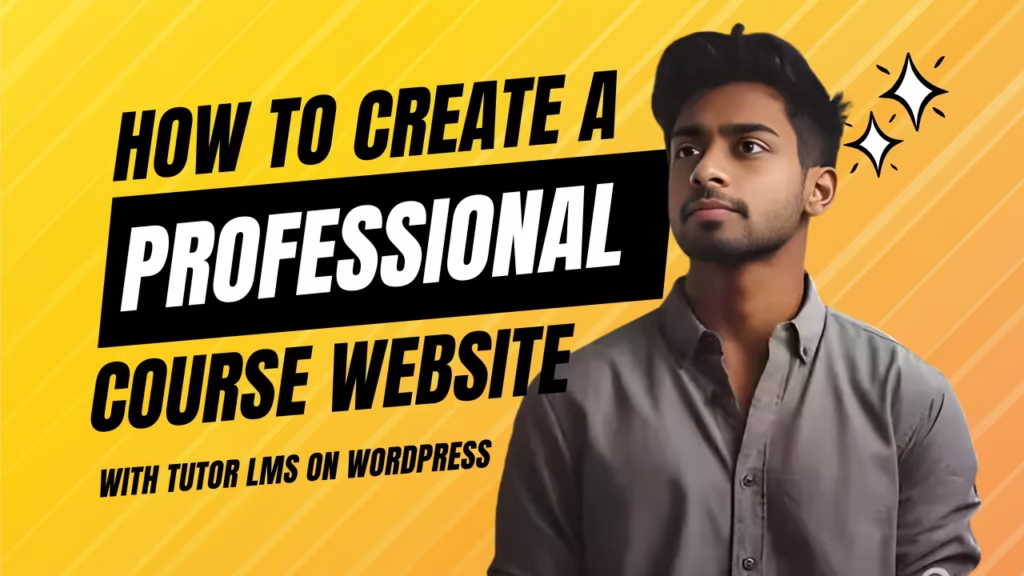Introduction
Welcome to the world of online education! Are you looking to create your own course website and have no idea where to start? Don’t worry, we’ve got you covered. In this blog post, we’ll discuss how you can use Tutor LMS and Elementor to create a professional course website on WordPress.
What are Tutor LMS and Elementor? Tutor LMS is a plugin that allows you to create and sell courses online, while Elementor is a drag-and-drop page builder that lets you customize the design of your website without needing any coding skills.
Using Tutor LMS and Elementor is not only easy but also incredibly beneficial for creating a course website. Tutor LMS provides you with all the essential features you need to create and sell courses, while Elementor offers flexibility in design customization, giving your website a professional and personalized touch that stands out from the rest.
In this post, we’ll walk you through the entire process of setting up your WordPress website, installing Tutor LMS, customizing your website with Elementor, adding essential course features, and marketing your course website. Let’s dive right in!
Setting up a WordPress Website
Setting up a WordPress website can be a daunting task, but don’t worry, we’ve got you covered. The first step is choosing a hosting provider – there are plenty out there, but we recommend selecting one that offers good value for money and great customer support. Next up, you want to select a domain name that represents your brand well. Keep in mind that shorter and more memorable domain names tend to perform better in the long run.
After you’ve selected your hosting provider and domain name, it’s time to install WordPress. This process should only take a few minutes, and there are plenty of resources out there to help you if you get stuck. With WordPress installed, you’ll need to select a theme for your website. Themes dictate the look and feel of your website, and there are plenty of great free and paid options out there to choose from.
It’s important to remember that setting up a WordPress website is just the beginning – you’ll need to put time and effort into customizing it to meet your needs. But don’t worry, with Tutor LMS and Elementor, you’re well on your way to creating a professional course website that your students will love.
Installing Tutor LMS
So, you have set up your website, chosen the perfect WordPress theme, and are ready to dive in with creating courses. The next step? Installing Tutor LMS, of course!
First things first, head to the plugins page in your WordPress dashboard, search for Tutor LMS and then download and activate the plugin. Easy peasy.
Next up, configure basic settings such as the course and lesson pages, course duration, and course progress bar. Customizing these basic features will create a unique and professional course website that stands out from the rest.
Finally, it’s time to create courses and lessons. Begin by brainstorming the course structure and defining the learning objectives. From there, add lessons and elements such as videos, audio, and quizzes to create engaging content that keeps your students hooked.
With Tutor LMS, creating a professional course website has never been easier. So, what are you waiting for? Get started with Tutor LMS and take your courses to the next level!
Customizing a Course Website with Elementor
So you have set up your WordPress website and installed Tutor LMS. Good job, you’re almost there! But your website still looks plain and boring. Now is the time to unleash your creativity and make your course website stand out. And how do we do that? By customizing it with Elementor, of course!
First things first, let’s install and activate Elementor. Once that’s done, we can start creating a custom header and footer that best fits our brand. This will give our website a professional touch and make it visually appealing. Taking care of these small details can go a long way in building trust with your audience.
Next up, let’s play around with customizing course pages and slides. This is where we can let our creativity run wild and make our course content more engaging by adding interactive elements such as videos, quizzes, and images. And if you really want to take things up a notch, create custom pop-ups for course offerings that leave your visitors wanting more.
But wait, there’s more! Elementor comes with a bunch of other features that we can use to give our website an edge. For instance, we can create payment options, add user registration and login pages, implement course reviews and feedback, and even add a course directory. The possibilities are endless!
So, what are you waiting for? Go forth and customize your course website using Elementor. Trust us, it’ll make all the difference.
Adding Course Features
Adding course features to your Tutor LMS course website can take it to the next level. Let’s dive into some key features you should consider implementing for your users.
Creating payment options is a must-have feature for any course website. With Tutor LMS, you can easily set up payment options for your courses using different payment gateways such as PayPal, Stripe, and more. This will allow your users to select the payment method that works best for them and ensures that you get paid for your hard work.
Adding a user registration and login page will enable your users to create an account and have access to your courses easily. It also gives you the ability to track their progress and maintain student records.
Implementing course reviews and feedback will help you to improve and deliver quality courses to your students. Your students’ reviews and feedback will also help to increase your course credibility and attract more students.
Adding a course directory will give an overview of all the courses available on your website and help your students choose the right course based on their preferences.
Adding these features to your Tutor LMS course website will take it to the next level. Your users will have a seamless experience on your website, making it easier for them to learn and grow.
Marketing Your Course Website
Marketing your course website is a key aspect of creating a successful online course. Once you have created your course and website, you need to make sure that your target audience knows about it. You can achieve this through various marketing strategies such as social media marketing, email marketing, and search engine optimization (SEO).
Social media marketing involves leveraging different social media platforms to create awareness and drive traffic to your course website. By creating social media accounts, posting regularly, and engaging with your audience, you can create a strong online presence and build a community around your course.
Email marketing involves collecting email addresses of potential students and sending them promotional messages to drive them to your course website. This can be achieved through creating lead magnets, providing valuable content, and using email list building tools.
SEO involves optimizing your website content and structure to increase organic traffic from search engines. This can be achieved through keyword research, on-page optimization, and link building.
By utilizing these marketing strategies, you can effectively promote your course website and attract a relevant audience, thereby increasing your chances of success.
Now that you have created a professional course website, it’s time to bring in some traffic and get people excited about your offerings. You can start by creating and implementing email marketing campaigns. Mailchimp and ConvertKit are popular options that allow you to segment your email lists and target specific groups with personalized messages. Offer exclusive discounts or early access to new courses to incentivize sign-ups.
Social media is another powerful tool for promoting your courses. Post your latest offerings on Facebook, Twitter, and LinkedIn. Take advantage of Instagram’s visual nature to showcase your course materials in action. You can even set up paid social media ads to target specific demographics and interests.
Finally, make sure your website is optimized for search engines. Use relevant keywords in your page titles, meta descriptions, and content. Google Analytics can help you track your website’s traffic and performance. Consider adding a blog to your website with industry news and tips to further boost your SEO.
Just remember, building an audience and driving traffic takes time and effort. Stay engaged with your followers, nurture your email list, and keep your courses fresh and exciting. Happy teaching!
Conclusion
Phew! That was quite a ride, wasn’t it? We covered everything from setting up a WordPress website to customizing it with Tutor LMS and Elementor, and even marketing it to potential students. To summarize, we learned how to create a professional course website that looks great and works well, and most importantly, how to make it appealing to learners all around.
Now, it’s time to take action and put all this knowledge into practice. With the right mindset, determination, and a bit of creativity, you too can create an amazing course website that will help people learn and grow. So, what are you waiting for? Start building that website today and let your imagination run wild! Good luck, and happy teaching!





